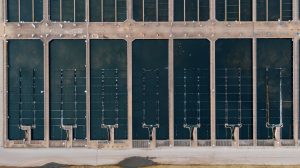Advances in sustainable aquaculture

Aquaculture, as an ever-evolving sector, has witnessed numerous innovations in its cultivation practices in recent years. These innovations have not only enhanced operational efficiency but also contributed to environmental sustainability. In this article, we will explore some of the latest trends that are revolutionizing the way we cultivate aquatic products.
1. Recirculating aquaculture systems (RAS)
One of the most significant advances in aquaculture has been the widespread adoption of Recirculating Aquaculture Systems (RAS). These closed systems enable water recycling and purification in controlled environments, reducing reliance on large water volumes and minimizing environmental impact. We will explore how RAS not only improves the living conditions of cultivated organisms but also optimizes resource utilization.
1.1. Water use efficiency:
One notable aspect of RAS is its ability to maximize water use. Unlike conventional methods where large amounts of water are continuously used and discharged, RAS operates in a closed loop. Water is constantly recycled and purified, minimizing the need for large volumes of fresh water. This approach not only reduces the demand for water resources but also decreases the risk of contamination of the surrounding water.
1.2. Precise environmental control:
Another significant advantage of RAS is the ability to maintain precise environmental control. From temperature to water quality, parameters can be adjusted and closely monitored. This is particularly beneficial for aquatic species sensitive to environmental fluctuations. Additionally, this control allows adaptation to various conditions, facilitating the breeding of a variety of species in a single system.
1.3. Reduced environmental footprint:
The adoption of RAS contributes to the reduction of the environmental footprint of aquaculture. By minimizing water discharge and efficiently managing waste, these systems help prevent eutrophication and sediment accumulation. Furthermore, by maintaining optimal conditions for cultivated organisms, the need for medications and chemicals is reduced, promoting more sustainable production.
1.4. Space optimization:
RAS allows greater flexibility in the location of aquaculture facilities. Since they are not limited by the availability of large bodies of water, producers can establish aquaculture farms in urban areas or regions with limited water resources. This optimizes space usage and facilitates the creation of more sustainable and decentralized aquaculture operations.
1.5. Improved product quality:
The final product’s quality is also enhanced by RAS. Precise environmental control translates into optimal farming conditions, leading to more uniform growth and superior quality of cultivated organisms. This not only meets market expectations in terms of taste and texture but also strengthens producers’ positions in the industry.
In conclusion, Recirculating Aquaculture Systems represent a key innovation in contemporary aquaculture. Their ability to improve water use efficiency, maintain precise environmental control, and reduce the environmental footprint makes these systems crucial for the sustainable future of aquaculture. The widespread adoption of RAS reflects a continued commitment to more environmentally friendly practices and more efficient aquaculture production.
Aquaponics has emerged as an innovative practice that combines fish farming with plant cultivation in a symbiotic system. We will examine how this comprehensive approach not only increases space efficiency but also creates a natural cycle where fish waste becomes nutrients for plants, and these, in turn, purify the water for fish.
2.1. How it works:
2.2. Benefits of aquaponics:
Aquaponics represents a significant innovation in aquaculture practices by providing a sustainable and efficient alternative that can adapt to various environments and production needs.
3. Automated Monitoring Technologies
The introduction of automated monitoring technologies has transformed the daily management of aquaculture operations. From sensors that monitor water quality to algorithm-based automated feeding systems, we will examine how these innovations not only improve productivity but also optimize operations, enhance the health of aquatic organisms, and ensure more sustainable production.
3.1. Water quality sensors:
3.2. Fish activity monitoring:
3.3. Biomass monitoring:
3.4. External indicators of animal welfare:
3.5. Automated feeding systems:
3.6. Benefits of automated monitoring technologies:
The implementation of automated monitoring technologies represents a significant step toward more efficient, sustainable, and adaptable aquaculture, ensuring an optimal balance between production and environmental care.
4. Sustainable aquaculture feed
The landscape of aquaculture has undergone a significant transformation due to a progressive focus on the development of sustainable feeds. Below, we will review how innovations in this area are reshaping traditional practices, with a special emphasis on alternatives to fishmeal and fish oil, and applied technologies to enhance the nutritional and physical quality of feeds.
4.1. Alternatives to fishmeal:
4.2. Alternatives to fish oil:
4.3. Technologies for sustainable feed development:
4.4. Contribution to the preservation of marine resources:
5. Global approach to sustainable aquaculture
The combination of alternatives to fishmeal, advanced technologies in feed development, and the integration of sustainable practices not only redefines feeding in aquaculture but also establishes a global approach to a more sustainable and ethical industry. These innovations not only benefit aquatic organisms but also pave the way for aquaculture that harmonizes with marine ecosystems and positively contributes to the overall well-being of the planet.
In conclusion, the development of sustainable feeds has been a key focus area in modern aquaculture. The exploration of alternatives to fishmeal, coupled with advanced technologies, not only ensures the health and growth of aquatic organisms but also aligns with the industry’s commitment to environmental sustainability and ethical production.
This article is presented by Aquanetwork, your reliable source for job opportunities in the aquaculture industry. Connect with employers and passionate professionals at Aquanetwork.